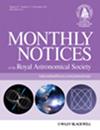宇宙网丝对星系演化的影响
IF 4.8
3区 物理与天体物理
Q1 ASTRONOMY & ASTROPHYSICS
引用次数: 0
摘要
众所周知,星系的特性会受到环境的影响。这一点在高密度星团环境和低密度场之间的极端密度尺度上已经得到证实。然而,人们对宇宙网丝的中间密度体系如何影响星系演化还不完全清楚。我们利用斯隆数字巡天 DR8 主星系样本(MStellar > 109.91M⊙)中的 23,441 个质量完整的星系样本来研究这种环境效应。我们定义了 6 种环境,它们探测了不同的密度机制,代表了结构形成过程中的独特阶段,并比较了它们之间恒星形成活动和形态的差异。我们发现,丝状环境中的星系往往比场环境中的星系更少形成恒星,更倾向于早期型形态。在考虑恒星质量匹配样本时,这些差异依然存在,这表明这是环境造成的结果。我们通过构建恒星质量和本地星系密度都匹配的样本,进一步研究这些趋势是大尺度环境还是本地环境的结果。我们发现,当同时匹配本地星系密度时,观测到的丝状群体和野外群体之间的差异消失了,从而得出结论,丝状群体的环境效应完全可以用本地星系密度指数来参数化。我们发现,在与星系团内部的比较中仍然可以看到差异,这表明这些星系团内部的环境是独特的,它们可以带来更多的物理过程,而这些过程并不是以本地星系密度为特征的。本文章由计算机程序翻译,如有差异,请以英文原文为准。
The effect of cosmic web filaments on galaxy evolution
Galaxy properties are known to be affected by their environment. This is well established for the extremes of the density scales, between the high-density cluster environment and the low-density field. It is however not fully understood how the intermediate-density regime of cosmic web filaments affects galaxy evolution. We investigate this environmental effect using a mass complete sample of 23,441 galaxies in the Sloan Digital Sky Survey DR8 Main Galaxy Sample (MStellar > 109.91M⊙). We define 6 environments, probing different density regimes and representing unique stages in the structure formation process, comparing the differences in star formation activity and morphology between them. We find that galaxies in filaments tend to be less star forming and favour more early-type morphologies than those in the field. These differences persist when considering stellar mass-matched samples, suggesting that this is a consequence of the environment. We further investigate whether these trends are a result of the large scale or local environment through constructing samples matched both in stellar mass and local galaxy density. We find that when also matching in local galaxy density, the differences observed between the filament and field population vanishes, concluding that the environmental effect of filaments can be entirely parameterised by a local galaxy density index. We find that differences can still be seen in comparisons with the interiors of clusters, suggesting these are unique environments which can impart additional physical processes not characterised by local galaxy density.
求助全文
通过发布文献求助,成功后即可免费获取论文全文。
去求助
来源期刊

Monthly Notices of the Royal Astronomical Society
ASTRONOMY & ASTROPHYSICS-
CiteScore
9.10
自引率
37.50%
发文量
3198
审稿时长
3 months
期刊介绍:
Monthly Notices of the Royal Astronomical Society is one of the world''s leading primary research journals in astronomy and astrophysics, as well as one of the longest established. It publishes the results of original research in positional and dynamical astronomy, astrophysics, radio astronomy, cosmology, space research and the design of astronomical instruments.
 求助内容:
求助内容: 应助结果提醒方式:
应助结果提醒方式:


